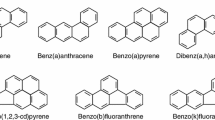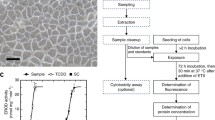Abstract
As a first step to assess biological activities of complex mixtures of polychlorinated dibenzo-p-dioxins (PCDDs), induction of 7-ethoxyresorufin O-deethylase (EROD) by defined mixtures and their constituents has been analysed in vitro. Two cell systems have been compared: primary hepatocyte cultures and hepatoma H4IIE cells. EC50 values of PCDDs were compared with that of the most potent compound, 2,3,7,8-Cl4DD (2,3,7,8-tetrachlorodibenzo-p-dioxin) and expressed as 2,3,7,8-Cl4DD equivalents (TEs). TEs for three defined mixtures containing up to 49 PCDDs could be predicted from the sum of TEs for the 2,3,7,8-substituted congeners. Efficacies (maximal enzyme induction) of less potent PCDDs (1,2,3,4-Cl4DD, Cl8DD and of a mixture containing 86% Cl8DD and of benz(a)anthracene were lower in hepatocytes (by 33%) and in H4IIE cells (by 50%). The results suggest that biological activities of complex PCDD mixtures are largely due to additive effects of their 2,3,7,8-substituted consituents.
Similar content being viewed by others
References
Barnes DG, Bellin J, Cleverly D (1986) Interim procedures for estimating risks associated with exposures to mixtures of chlorinated dibenzodioxins and dibenzofurans (CDDs and CDFs). Chemosphere 15: 1895–1903
BGA (1985) Sachstand Dioxine, Bericht 5/85 des Umweltbundesamts (BRD). E. Schmid Verlag, Berlin p 264
Birnbaum LS, Weber H, Harris MW, Lamb JC, McKinney JD (1985) Toxic interaction of specific polychlorinated biphenyls and 2,3,7,8-tetrachlorodibenzo-p-dioxin: increased incidence of cleft palate in mice. Toxicol Appl Pharmacol 77: 292–302
Bock KW, Schirmer G, Green MD, Tephly TR (1988) Properties of a 3-methylcholanthrene-inducible UDP-glucuronosyltransferase from rat liver. Biochem Pharmacol 37: 1439–1443
Bradlaw JA, Casterline JL (1979) Induction of enzyme activity in cell culture: a rapid screen for detection of planar polychlorinated organic compounds. J Assoc Off Anal Chem 62: 904–916
Burke MD, Mayer RT (1974) Ethoxyresorufin: direct fluorimetric assay of a microsomal O-dealkylation which is preferentially inducible by 3-methylcholanthrene. Drug Metab Dispos 2: 583–588
Hagenmaier H, Brunner H (1987) Isomerspecific analysis of pentachlorophenol and sodium pentachlorophenate for 2,3,7,8-substituted PCDD and PCDF at sub-ppb levels. Chemosphere 16: 1759–1764
Hagenmaier H, Brunner H, Haag R, Kraft M (1987) Copper-catalyzed dechlorination/hydrogenation of polychlorinated dibenzo-p-dioxins, polychlorinated dibenzofurans, and other chlorinated aromatic compounds. Environ Sci Technol 21: 1085–1088
Lowry OH, Rosebrough NJ, Farr AL, Randall RJ (1951) Protein measurement with the Folin phenol reagent. J Biol Chem 193: 265–275
NATO/CCMS (1988) Pilot study on international information exchange on dioxins and related compounds. International toxicity equivalent factors (I-TEF). Method of risk assessment for complex mixtures of dioxins and related compounds. Report number 176
Nebert DW, Gonzalez FJ (1987) Structure, evolution, and regulation. Ann Rev Biochem 56: 945–993
Pluess N, Poiger H, Hohbach C, Schlatter C (1988) Subchronic toxicity of some chlorinated dibenzofurans (PCDFs) and a mixture of PCDFs and chlorinated dibenzodioxins (PCDDs) in rats. Chemosphere 17: 973–984
Poland A, Knutson JC (1982) 2,3,7,8-Tetrachlorodibenzo-p-dioxin and related halogenated aromatic hydrocarbons: examination of the mechanism of toxicity. Annu Rev Pharmacol Toxicol 22: 517–554
Rizzardini M, Romano M, Tursi F, Salmona M, Vecchi A, Sironi M, Gizzi E, Benfenati E, Garattini S, Fanelli R (1983) Toxicological evaluation of urban waste incinerator emissions. Chemosphere 12: 559–564
Safe SH (1986) Comparative toxicology and mechanism of action of polychlorinated dibenzo-p-dioxins and dibenzofurans. Annu Rev Pharmacol Toxicol 26: 371–399
Safe SH (1987) Determination of 2,3,7,8-TCDD toxic equivalent factors (TEFs): support for the use of the in vitro AHH induction assay. Chemosphere 16: 791–802
Sawyer T, Safe S (1982) PCB isomers and congeners: induction of aryl hydrocarbon hydroxylase and ethoxyresorufin O-deethylase enzyme activities in rat hepatoma cells. Toxicol Lett 13: 87–94
Wiesmüller T (1990) Thesis, University of Tübingen
Whitlock, JP, Jr, Miller H, Gelboin HV (1974) Induction of aryl hydrocarbon (benzo[a]pyrene) hydroxylase and tyrosine aminotransferase in hepatoma cells in culture. J Cell Biol 63: 136–145
Wölfle D, Münzel P, Fischer G, Bock KW (1988) Altered growth control of rat hepatocytes after treatment with 3,4,3′,4′-tetrachlorobiphenyl in vivo and in vitro. Carcinogenesis 9: 919–924
Author information
Authors and Affiliations
Rights and permissions
About this article
Cite this article
Schrenk, D., Lipp, HP., Wiesmüller, T. et al. Assessment of biological activities of mixtures of polychlorinated dibenzo-p-dioxins: Comparison between defined mixtures and their constituents. Arch Toxicol 65, 114–118 (1991). https://doi.org/10.1007/BF02034936
Received:
Accepted:
Issue Date:
DOI: https://doi.org/10.1007/BF02034936




